Ruby is a modern-day programming language developed in Japan around the 90s. This high-level language is intended for general-purpose software development. Ruby gained immense popularity during the transition of websites to web apps. It fuels the first generation of these apps due to its high-scalability and robust feature set. Even after the JS boom, Ruby is still enjoying increasing demand. Companies often seek developers fluent in Ruby and Rails, Ruby’s flagship web framework for maintaining their existing products and adding new functionalities. So, it’s essential to know common ruby interview questions if you want to grab a Ruby job.
Frequently Asked Ruby Interview Questions
Companies can ask all sorts of questions in a Ruby job interview. Enterprises with large teams usually want to know the depth of a developer during these interviews. Startups, on the other hand, generally look for more experienced developers capable of building business products quickly. It’s important to know Ruby’s use in product development alongside the basics.
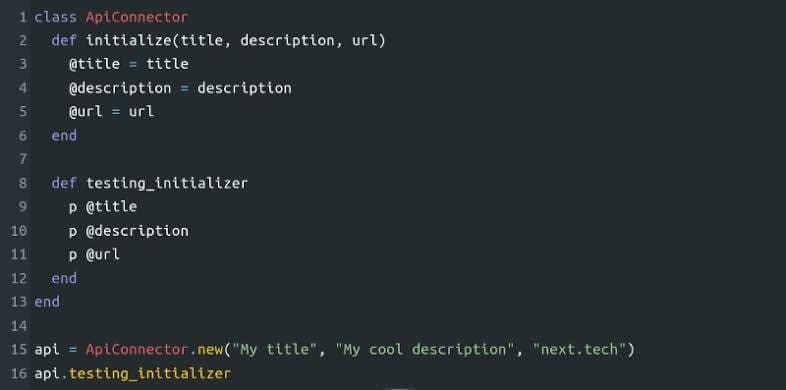
1. What is Ruby?
Ruby is a general-purpose language used for developing all types of tech products. It’s easy to build web apps with Ruby thanks to its popular server-side development platform, Rails. Ruby offers exceptional versatility to developers due to its robust abstraction layers. Ruby programs, however, are not the fastest due to this same reason. Moreover, programmers find Ruby very flexible when design interfaces.
2. Who Developed Ruby?
A Japanese programmer named Yukihiro “Matz” Matsumoto developed Ruby. He implemented it using the C programming language. The reference implementation of Ruby, known as MRI (Matz’s Ruby Interpreter), is also developed by him.
3. What Are the Best Features of Ruby?
Ruby is an object-oriented programming language that allows duck, dynamic, and strong typing. Mixins allow Ruby developers to implement flexible single inheritances. It offers a large number of standard libraries, native plugin APIs, centralized package management, multi-level variable scope, first-class continuations, and a robust garbage collector, among many others.
4. What is the Best Alternative to Ruby?
Python is one of the best alternatives to Ruby. They are both interpreted languages and offer support for major standard libraries. Both of them are suitable candidates for building modern web applications. The Ruby on Rails web framework is very capable, and so is the Django and Flask framework for python. Additionally, Ruby, and Python both allow developers to create other generalized software such as system utilities, communication tools, and cross-platform applications.
5. Why Develop Web Apps Using Ruby?
Among a plethora of ruby interview questions, job seekers are often asked the reason to use Ruby for building web applications. The obvious reason is the Ruby on Rails framework. Rails is known for its superior prototyping abilities. Developers can quickly prototype new product ideas using already existing structures and components. So products can be visualized with as few lines of codes as possible. It’s one of the best selling points of Ruby.
6. How to Verify Ruby Version Number?
It’s very easy to verify whether ruby is installed in a system and, if so, which version of it. Simply use the next command to verify the ruby version number in Linux and Unix-based distributions.
$ ruby -v $ ruby --version
It will output the version number given ruby is already installed. Else, a command not found prompt will be returned.
7. What Class Libraries are Available in Ruby?
Class libraries are built-in libraries for different domains such as threading, communication, and data types. Ruby comes with some of the following class libraries-
- CGI(Common Gateway Interface) programming
- GUI(Graphical User Interface) programming
- XML(Extensible Markup Language) programming
- Networking
- Text Processing
These are some tasks for which Ruby already provides some pre-built functionalities. Developers can create any type of personalized libraries they want using Ruby.
8. What Are the Commonly Used Operators in Ruby?
As with notable programming languages, Ruby also offers a number of primitive operators for computation. Operators define the operation needed to perform using your code. The basic operators are listed below –
- Unary operator – works on a single operand such as not(!).
- Arithmetic operator – operators for standard mathematics such as +, -, *, /.
- Logical operator – works with boolean and logical data such as AND, OR.
- Bitwise operator – works with binary numerals.
- Ternary operator – takes three arguments.
9. Which of the Following Expressions Returns False?
true ? "True" : "False" false ? "True" : "False" nil ? "True" : "False" 1 ? "True" : "False" 0 ? "True" : "False" [] ? "True" : "False"
Interviewers often test the fundamental of job seekers using one or more of the above expressions. Even experienced programmers with knowledge of languages like Python and JavaScript may fail to answer it. Ruby evaluates only false and nil values as false. Constructs like 0 and [] evaluate to true.
10. What are the Values of the Below Variables after Execution?
number1 = true and false number2 = true && false
It’s another example of commonly asked ruby interview questions. Although seemingly equivalent at first glance, their evaluation may surprise you. If you print them, you’ll get number1 to be true and number2 as false. This happens because = (assign operator) has higher precedence in Ruby than the logical and operator.
So the first expression is just telling the interpreter to perform (number1 = true) and false, which results in number1 being true. However, the && operator has higher precedence than =, and so the second expression evaluates as expected.
11. Can You Explain the Variable Types in Ruby?
As with other programming languages, Ruby utilizes variables to hold various program data. Variables in Ruby works somewhat similar to Python. Ruby has four default variable types. They are –
- Local variable – used for holding general program values.
- Global variable – holds data throughout the global scope.
- Class variable – holds static data related to class objects, singular entity.
- Instance variable – holds instance data of a class, different for each object.
12. What are the Differences between Nil and False?
We’ve already told you about the nil and false constructs available in Ruby. Although both of them evaluates as false when used inside expressions, there’re subtle differences between them. For one, nil can’t be a value but false can. Usually, Ruby programs return nil when there is no predicate, and in the case of predicates, either true or false gets returned. False is also a boolean data type, whereas nil doesn’t represent any type.
13. Discuss the Basic Data Types Used in Ruby.
Candidates are often inquired for their knowledge of data types in ruby on rails interview questions. As a general-purpose programming language, Ruby supports multiple data types that facilitate different aspects of our projects. The basic data types available in Ruby are –
- Number – represents numeral values like integer and floats.
- String – represents string/text values.
- Boolean – represents boolean values, True and False.
- Array – holds list data.
- Hashes – holds multi-dimensional data using key-value pairs.
- Symbols – a lightweight alternative to strings, delivers high performance.
14. Differentiate between Load and Require
Ruby offers two distinct ways to include external code snippets in your codebase, namely load and require. Although seemingly similar, there’re subtle differences among them. The load should be used for cases where the external code is required on each change of event. On the other hand, require acts as autoload and should be used for including code snippets automatically.
15. How to Deal with Conditionals in Ruby?
Conditional constructs lie at the center of modern programming languages. They control the flow and execution of your program. Most languages today offer some kind of (if – then – action) construct for this purpose. Ruby can handle conditional using different variations of the classic if construct.
- If – evaluates code based on primitive condition.
- If-Else – handles program flow in both ways based on condition.
- Unless – executes code only when conditional is false.
- Case – allows developers to specify program execution in multiple directions.
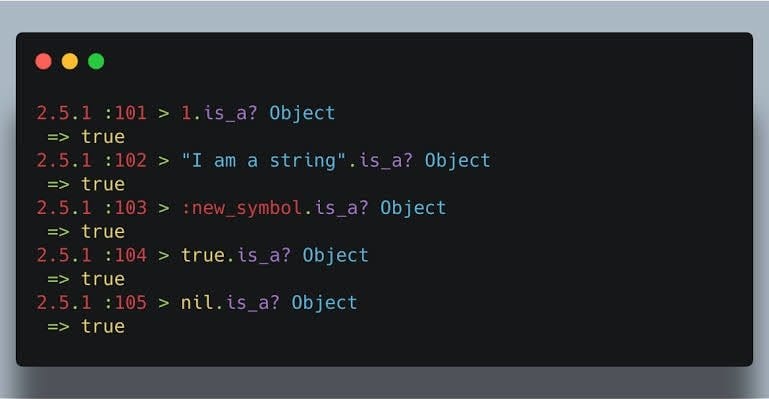
16. How Do Loops Work in Ruby?
Loops are the preferred way to perform iterations for the majority of programmers. Ruby offers some different loop constructs to facilitate this. We take a short look at them below.
- While loop – works until the defined condition becomes false.
- For loop – uses the classic for loop syntax alongside different variations.
- Do While loop – almost like While, but executes code at least once.
- Until – works until a defined condition becomes true.
17. How do Breaks Work in Ruby?
The break construct is common across major programming languages. It works the same in Ruby. You can use the break statement to break free out of a scope literally. Programmers often use it to backtrack from within loops and recursive functions. Below, we demonstrate how to break out of a for loop in Ruby.
#!/usr/bin/ruby
for i in [1, 2, 3, 4, 5] do
puts i
if i == 3
break
end
end
This code will print up to 3 and then terminate. This happens since we’ve used “break” as soon as “i equals to three”.
18. Why Use the Next Statement?
The next statement in Ruby is a complement to the break statement. It’s used for skipping a specific iteration of the loop and continue to the next one. It is equivalent to the continue statement in C and next in Perl. The following command skips the second iteration but proceeds to the third one.
#!/usr/bin/ruby
for i in 1...6
if i == 2 then
next
end
puts i
end
Since questions on loop iterations are common in ruby interview questions, be careful when answering them.
19. How do Redo Statements Work?
Redo statements can be used to re-evaluate a certain iteration in your loop. The condition of the loop isn’t executed in case of the redo statement. The below snippet provides a simple example.
for i in 1...6 puts i i += 1 and redo if i ==2 end
If you increment the counter after the redo statement, it will never get executed. So your program will fall into an infinite loop. This is a common mistake with new Ruby programmers.
20. How do Retry Statements Work?
The retry statement is a handy way to repeat loop iterations in Ruby. Using the retry statement often proves to be a little challenging for many seasonal programmers.
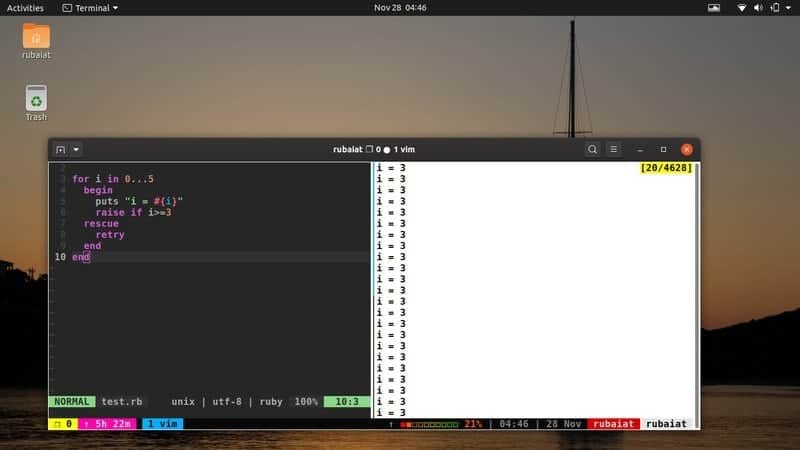
#!/usr/bin/ruby
for i in 0..5
begin
puts "i = #{i}"
raise if i >=3
rescue
retry
end
end
This code snippet will fall into an infinite loop. This happens since the condition to if always evaluates true. And then the iteration keeps retrying the iteration.
21. How to Use Comments in Ruby?
Comments are essential for readability and documentation. Ruby supports Python-like single line comment. Simply append an # before the portion of code you want to comment out.
# comment = 1 puts comment
You should get a NameError since your program has no idea about the variable you commented out. Multi-line comments are also available in Ruby.
=begin puts "hello" =end
This code won’t be evaluated and thus print nothing.
22. Is the Following Ruby Statement Valid?
->(a) {p a}["Hello Universe"]
The above ruby statement is perfectly valid. It simply creates a proc using the shorthand (->) notation. This proc is also a lambda. It takes a as the parameter, prints it, fires that proc, and passes the parameter “Hello Universe”. So, the result should be simply “Hello Universe”.
23. How to Create Objects in Ruby?
Many employers like to ask about objects and classes during their ruby interview questions. Thankfully, it’s very easy to create objects of a class in Ruby. You’ll simply require the class name of the object and can store it like variables.
object1=className.new
Now, object1 will hold a new instance of the className class.
24. How to Create Classes in Ruby?
Classes are the prototypes of your objects. It also defines the methods allowed on these. You’ll need to create the class before you can instantiate an object. The below code snippet demonstrates how to create a simple class in Ruby.
class className # codes here end
Now you can easily create an object using the method shown in the previous question.
25. How to Create Methods?
Ruby methods are equivalent to functions in other languages like C and Python. It prevents programmers from writing the same code blocks inside their program. Once you define a method, you can call it from anywhere in your program. Check out the next example.
def Loop
for i in 0...10
puts i
end
end
Loop()
Now you can call this method as shown in the last line to print out the numbers 0 to 9 from anywhere in your source code.
26. Can You Explain Different Equal Operators of Ruby?
Ruby provides several equal operators to check the equality of numerals and objects. Each operator has slightly different use cases, which confuse new programmers pretty often. We take a look at four different equal operators in Ruby below.
- == – standard equal operator, checks only values not types
- === – used for checking equality from within when clauses in case statements.
- eql? – checks both the value and the type of the operands.
- equal – checks the identity of two objects, returns true only when both objects have the same id.
27. Differentiate Between super and super() in Ruby
Although similar at first glance, super and super() has quite differences. The super call invokes the parent method by passing the same arguments passed to the child method. It can often lead to unexpected behavior due to possible mismatch in the parent method’s parameters. However, calling super() invokes the parent method directly without passing any parameters.
28. How to Pass Reference in Ruby?
Ruby doesn’t offer pointers, and related dereference. However, it still allows programmers to pass references instead of local variables. This can be done using the ampersand (&) symbol. Take a look at the below code to understand how this works in ruby.
#! /usr/bin/ruby
def method(&block)
puts "This is method"
block.call
end
method { puts "This is block reference" }
If you get errors, be sure to check your indentation and whitespaces.
29. How do Modules Work in Ruby?
Modules in Ruby are collections of constants and methods. They are defined as classes and share many similar traits in common such as class definitions, constants, and other modules. However, Ruby doesn’t allow the creation of objects using modules. Also, there’s no support for inheritance.
The purpose of a module is to provide namespaces for preventing naming clashes. Additionally, they enable mixins to share common functionalities among classes.
30. How do Mixins Work in Ruby?
Since Ruby doesn’t offer multiple inheritances to class objects, programmers need a different way to do this. So modules are used for getting around this issue. Although modules can’t be instantiated, they can be included easily within different classes. So, you can still have access to the methods defined in a module by including it to a class. Mixins get their name from the “mix-ins” of modules inside a class.
31. Is It Possible to Call a Private Method Outside a Ruby class?
Yes, it is possible in Ruby. We’ll need to use an object of the class to call a method private to it. This can be done using the send method. The below code demonstrates this in action.
class ClassName
private
def method
p "This is a private method"
end
end
We can now call this private method from the Ruby interpreter using the below line.
>> ClassName.new.send(:method)
32. Explain the Differences between Include and Extend
You can use your modules using both the include and extend statements. However, they are quite different and used for specific purposes. In short, include adds the module methods to an object of the class, whereas extend adds class methods.
33. How to Access String Elements in Ruby?
Strings are one of the core data types offered by Ruby. Anything surrounded by ” ” is a string in Ruby. You can get the elements of a Ruby string easily using square [] brackets. The below code snippet demonstrates this.
#! /usr/bin/ruby foo = "something to do with strings" length = foo.length for i in 0...foo.length p foo[i] end
This code block will print out all the characters of the given string one by one in the standard output.
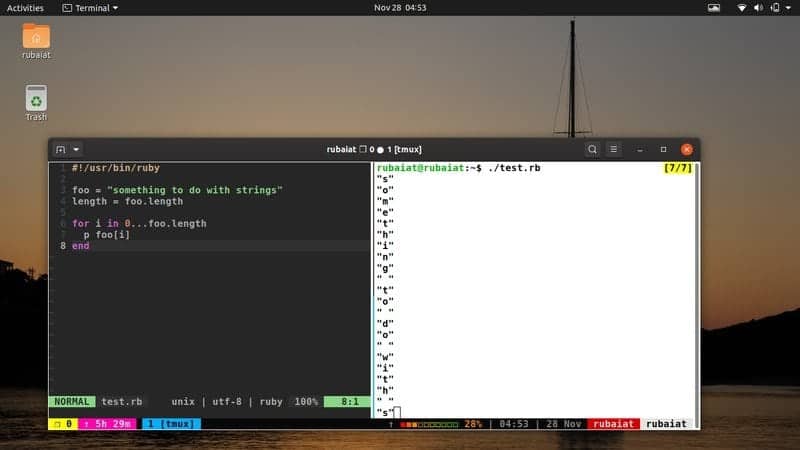
34. Is It Possible to Write Multi-Line Strings in Ruby?
During many ruby interview questions, job seekers are asked whether it is possible to write multi-line strings in Ruby. Although you might not be familiar with it, it’s possible and easy to do. Below we demonstrate three different ways to do this in Ruby.
puts " R Ru Rub Ruby" puts %/ R Ru Rub Ruby/ puts<<STRING R Ru Rub Ruby STRING
35. What is the Difference Between clone and dup?
Ruby provides two robust methods for cloning/duplicating objects in your program. Although they might seem to do the same thing, there’s quite some difference — a call to clone copies the entire Object, including the module mixins. However, dup creates a shallow copy of Object and doesn’t copy any mixins.
36. How to Remove the Nil Values from Ruby Arrays?
Since nil is a valid type in Ruby, you’ll often find it across your program. Programmers need to make sure they remove as many such occurrences as possible throughout their codebase. It’s quite straightforward to find and remove these nil values from arrays in Ruby. The below code snippet will provide a demonstration.
arr = [nil,"test",nil,"test",nil, "test"].compact puts arr
Although the arr construct hols six value objects, it prints just three of them, all non-nil values. The compact method allows us to do this.
37. Write a Ruby Program to Generate Fibonacci Numbers
Many employers like to ask classic number theory related questions during ruby interview questions. Fibonacci series is certainly one of the favorites among interviewers. Each number in this series is the sum of its previous two numbers. The below snippet can generate a simple Fibonacci series.
first_number=0
second_number=1
next_term=0
puts "How many terms:-"
n=gets.chomp.to_i
puts "The first #{n} terms of Fibonacci series:-"
i=1
while(i<=n+1)
if(i<=1)
next_term=i
else
puts next_term
next_term=first_number+second_number
first_number=second_number
second_number=next_term
end
i+=1
end
38. Can You Differentiate Between Procs and lambdas?
Both procs and lambdas are part of closures, the lexical scope of a function or code block. They are used for packaging or group code blocks for increasing readability. Blocks are also closures, but they aren’t objects like procs or lambdas. Procs and lambdas can also be returned from within functions. However, they are quite different. In short, all lambdas are procs, but not all procs are lambdas. Lambdas are strict when checking parameter numbers, but procs aren’t. Lambdas return simply values, whereas procs return values from the current scope.
39. How to Control Access Levels for Ruby Methods?
Ruby enables programmers to control the access levels of their methods easily. You can make your methods either public, private, or protected. This way, you can specify which objects have access to which methods throughout your program. As suggested by the name, public methods can be accessed by anyone. Private methods are only accessible to objects of that class to whom the methods belong. Protected methods, on the other hand, are only accessible to the class it’s defined in and its subclasses.
40. What are Gems in Ruby?
Gems have become a popular concept since its inceptions. Ruby gems are ruby programs distributed as packages. They have been a vital factor behind Ruby’s success. It’s very easy to package your application and share/deploy it using gems. The simple but productive CLI interface of this package manager is very flexible and allows developers to package their program effortlessly. Ruby gems package manager now comes in-built with the standard Ruby runtime.
41. What is Rails Engine?
Potential candidates are often asked about rails engines during ruby on rails interview questions. The Rails Engine is a mechanism that allows programmers to wrap their rails application or some specific functionalities with other applications or part of larger distributable packages. You can think of Rails Engines as mini-apps. Access to these engines depends on the routing policy of your server. You simply mount the engine, and routers can use it.
42. How to Freeze Objects in Ruby?
Ruby allows programmers to freeze objects during the execution of their programs. This may come in handy in a number of situations. The below code snippets demonstrates the freezing of Ruby objects in action.
foo = "something" foo.freeze if( foo.frozen? ) puts "foo is a frozen object" else puts "foo is a regular object" end
So the freeze method is used for freezing the object and frozen? to check its state. If you comment out the second line, you’ll get the output of the else block.
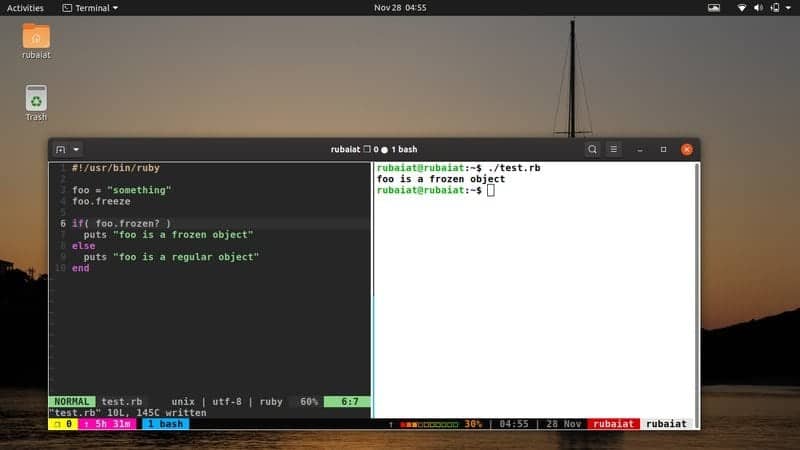
43. Discuss the CRUD Verbs Available in Rails
CRUD is the basic building block of RESTful APIs. The Rails framework allow all major CRUD operations. We discuss the Rails web verbs below.
- GET – this verb is used for fetching page resources
- POST – creating and submitting new resources
- PATCH/PUT – update existing resources
- DELETE – remove specified resources
44. What is the Relationship between Thread Pooling and Thread Lifecycle?
Single thread lifecycles in Ruby are started automatically as soon as your CPU has available resources. Although threads are resource-hungry, you can improve the speed of your Ruby on Rails application significantly by using multiple threads at the same time. The thread pooling technique is used widely for facilitating the interrupt-free working of multiple threads. In this technique, multiple already existing reusable threads are awaited on standby. Whenever new resources are available, new threads start automatically.
45. What are the Best Tools for Testing Rails Applications?
One of the most common ruby interview questions faced by job seekers is about testing tools. Since Ruby on Rails is used extensively for building large-scale web applications, testing is an extremely important part. Thankfully, a substantial number of pre-built tools exist to increase testing speed and outcome for new Ruby developers. Some popular and useful testing tools for Rails are –
- rspec – a domain-specific tool for testing ruby code
- minitest – a full-fledged testing suite that supports TDD, BDD, benchmarking, and fast prototyping.
- test-unit – a robust unit testing framework for Ruby based on xUnit principles.
- cucumber – a flexible Ruby tool for running automated tests for Ruby.
46. How Many Ways Can You Add Items to Ruby Arrays?
As discussed already, arrays are an important data structure in Ruby. There’re multiple ways to add new items to an already existing array. Some of them are shown below.
foo = ["something", "ufo", "what?"]
puts foo
foo.push("bar")
puts foo
foo.unshift("newItem")
puts foo
foo.insert(1, "anotherNewItem")
puts foo
The push method adds new elements at the end of the array, unshift at the beginning, and insert to add items in any specified position.
47. How Many Ways Can You Remove Items from Ruby Arrays?
Removing items from arrays is also no big deal in Ruby. Programmers can use various methods for doing this. We provide a simple demonstration below. It’s part of another common ruby interview questions you may face.
foo = ["something", "ufo", "what?", "anotherNewItem", "newItem", "bar"]
foo.pop
puts foo
foo.shift
puts foo
foo.delete("ufo")
puts foo
foo.uniq
puts foo
So, pop deletes the last item of the array, shift the first, and delete specific items. The uniq method removes duplicate items from the array.
48. How to Store Secure Data in Rails?
Rails applications often deal with sensitive information like passwords, usernames, IP addresses. It’s an extremely bad idea to store these data as plaintext. You should always take proper measurements to ensure data safety. Third-party data like payment and background information should be stored via specialized services like Stripe. Encrypt database data before storing them. Make sure network data is sent and received using secure connections to prevent eavesdropping.
49. How to Handle File Operations in Ruby?
Like other programming languages, files and their manipulation consist of a major part in Ruby programming. Thanks to Ruby’s robust libraries and built-in methods, handling files in Ruby is quite effortless. Check out the below snippet for understanding some file operations.
new_file = File.open("test.txt")
file_data = new_file.read
new_file.close
file_data = File.read("test.txt").split
File.open("test.txt", "w") { |f| f.write "#{Time.now} - New Data Written\n" }
File.write("test.txt", "data...", mode: "a")
50. How to Handle Exceptions Using Catch in Ruby?
In many ruby interview questions, interviewers ask candidates how they should handle exceptions in Ruby programs. Like other modern languages, Ruby allows programmers to catch runtime errors and handle them without crashing the entire application. The syntax is, however, somewhat different from try-catch statements found in other languages.
throw :Label_Name #.. code will not be executed catch :Label_Name do #.. execute matching catch if the throw is encountered. end
Ending Thoughts
Since Ruby interview questions can vary depending on the position you’ve applied for and the company, it’s hard to encompass all possible questions in a single guide. However, our editors have tried their best to outline the most commonly asked Ruby on Rails interview questions to help in your job preparations. If you’re new to Ruby, we suggest you not to jump straight into complex questions or techniques. Instead, you should always try to master the basics and create simple real-life projects. This will help you tackle interviews much more effortlessly. Stay with us for more guides on demanding CS jobs.
